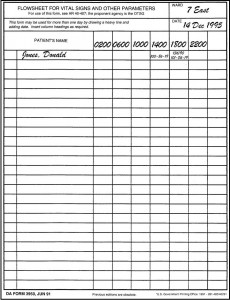If you are taking vital signs on a ward, you will probably enter your readings on the DA Form 3950. The form provides room to record the vital signs for several patients over an extended period (normally one day).
a. Identification Information.
The name of the patient’s are entered in the first column on the right. The time (approximate military time) that you are taking the vital signs is entered in the heading of the next column. Normally, vital signs are taken every 4 hours (6 times a day).
b. Vital Signs Information.
(1) The patient’s temperature. The patient’s temperature, pulse rate, and breathing (respiration) rate are entered in that order. The sets of numbers are normally separated by a hyphen to make reading easier. Temperature readings with tenths are normally written with the tenths raised (for example, 986). The degree symbol and Fahrenheit or Celsius symbol are not written in order to save space. For example, figure 6-5 shows that Mr. Jones’ vital signs at 1400 were:
(a) Temperature: 100.0º F.
(b) Pulse rate: 86 beats per minute.
(c) Breathing rate: 19 breaths per minute.

(2) Blood pressure. When a patient’s blood pressure is taken, it is recorded in the same block as the TPR readings, but above those readings. The systolic-slash-diastolic form is used. The abbreviation “mm Hg” is not entered in order to save space. At 1600, Mr. Jones’ vital signs were taken again. This time, his blood pressure was also taken. His blood pressure readings were:
(a) Systolic: 136 mm Hg.
(b) Diastolic: 90 mm Hg.
c. General Rules.
The readings recorded on the DA Form 3950 conform to general rules given previously in this subcourse. These rules are summarized below.
(1) All Fahrenheit temperatures are to be rounded to the nearest two-tenths of a degree.
(2) All Celsius temperatures are to be rounded to the nearest one-tenth of a degree.
(3) All rectal temperatures are to have a circled “R ” above the temperature reading.
(4) All axillary temperatures are to have a circled ” A ” above the temperature reading.
(5) All temperatures without a special symbol are understood to be oral temperatures.
(6) All pulse rates are to be recorded in even whole numbers.
(7) All blood pressure readings are to be recorded in even whole numbers. The systolic (highest) pressure is entered in front of the diastolic (lowest) pressure. The systolic and diastolic readings are separated by a slash (diagonal line), such as “130/96.”
(8) All breathing rates are recorded as whole numbers. The numbers may be either even or odd.
